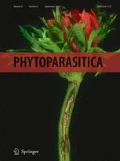Abstract
Clematis manshurica Pupr. is a perennial herb in the Ranunculaceae family, which has been used as a valuable traditional Chinese medicine. Between 2012 and 2013, a powdery mildew causing significant damage to plants of C. manshurica occurred in the Medicinal Herb Garden in Shenyang Agricultural University, Liaoning province, China. The fungus from symptomatic tissues was identified as Erysiphe aquilegiae based on morphological characteristics and rDNA ITS sequence analysis. To the best of our knowledge, this is the first formal report of powdery mildew on C. manshurica caused by E. aquilegiae in China.



References
Chinese Academy of Sciences. (1987). Editorial board of flora spore-producing plants: Flora fungorum sinicorum: Erysiphales. Beijing, China: Science Press.
Cook, R. T., Henricot, B., Henrici, A., & Beales, P. (2006). Morphological and phylogenetic comparisons amongst powdery mildews on Catalpa in the UK. Fungal Biology, 110, 672–685.
Cunnington, J. H., Lawrie, A. C., & Pascoe, I. G. (2004). Unexpected ribosomal DNA internal transcribed spacer sequence variation within Erysiphe aquilegiae sensu lato. Fungal Diversity, 16, 1–10.
Cunnington, J. H., Takamatsu, S., Lawrie, A. C., & Pascoe, I. G. (2003). Molecular identification of anamorphic powdery mildews (Erysiphales). Australasian Plant Pathology, 32, 421–428.
Fu, J. F., Su, W. N., Zhou, R. J., Sun, J. M., & Wang, D. Z. (2013). The pathogen identification and biological characteristics of Clematis manshurica spot blotch. Journal of Shenyang Agricultural University, 44, 26–31.
Hirata, T., Cunnington, J. H., Paksiri, U., Limkaisang, S., Shishkoff, N., Grigaliunaite, B., et al. (2000). Evolutionary analysis of subsection Magnicellulatae of Podosphaera section Sphaerotheca (Erysiphales) based on the rDNA internal transcribed spacer sequences with special reference to host. Canadian Journal of Botany, 78, 1521–1530.
Hirata, T., & Takamatsu, S. (1996). Nucleotide sequence diversity of rDNA internal transcribed spacers extracted from conidia and cleistothecia of several powdery mildew fungi. Mycoscience, 37, 283–288.
Jankovics, T., Bai, Y., Kovács, G. M., Bardin, M., Nicot, P. C., Toyoda, H., et al. (2008). Oidium neolycopersici: intraspecific variability inferred from amplified fragment length polymorphism analysis and relationship with closely related powdery mildew fungi infecting various plant species. Phytopathology, 98, 529–540.
Jiang, N., Huang, Y. C., Tang, M. Q., Lin, Y., Liu, W., & Tan, L. Y. (2010). Identification of Clematis chinensis black spot and screening of effective fungicides. Chinese Agricultural Science Bulletin, 26, 221–225.
Kiss, L., Cook, R. T. A., Saenz, G. S., Cunnington, J. H., Takamatsu, S., Pascoe, I., et al. (2001). Identification of two powdery mildew fungi, Oidium neolycopersici sp. nov. and O. lycopersici, infecting tomato in different parts of the world. Fungal Biology, 105, 684–697.
Kiss, L., Takamatsu, S., & Cunnington, J. H. (2005). Molecular identification of Oidium neolycopersici as the causal agent of the recent tomato powdery mildew epidemics in North America. Plant Disease, 89, 491–496.
Kovács, G. M., Jankovics, T., & Kiss, L. (2011). Variation in the nrDNA ITS sequences of some powdery mildew species: do routine molecular identification procedures hide valuable information? European Journal of Plant Pathology, 131, 135–141.
Lebeda, A., Mieslerová, B., Petřivalský, M., Luhová, L., Špundová, M., Sedlářová, M., et al. (2014). Resistance mechanisms of wild tomato germplasm to infection of Oidium neolycopersici. European Journal of Plant Pathology, Special Issue: Wild Plant Pathosystems, 138, 569–596.
Liberato, J. R., & Cunnington, J. H. (2006). First record of Erysiphe aquilegiae on a host outside the Ranunculaceae. Australasian Plant Pathology, 35, 291–292.
Mieslerová, B., Lebeda, A., Kennedy, R., & Novotný, R. (2002). Comparative morphological studies on tomato powdery mildew (Oidium neolycopersici). Acta Phytopathologica et Entomologica Hungarica, 37, 57–74.
Shi, S. P., Jiang, D., Dong, C. X., & Tu, P. F. (2006). Lignans from the roots and rhizomes of Clematis manshurica. Zeitschrift für Naturforschung B - Journal of Chemical Sciences, 61, 1299–1303.
Wolcan, S., & Park, J. H. (2012). First confirmed report of powdery mildew caused by Erysiphe aquilegiae on Casuarina cunninghamiana in Argentina. The Plant Pathology Journal, 28, 453–453.
Author information
Authors and Affiliations
Corresponding author
Rights and permissions
About this article
Cite this article
Zhou, R., Xu, H., Ou, Y. et al. Morphological and molecular identification of powdery mildew of Clematis manshurica caused by Erysiphe aquilegiae in China. Phytoparasitica 43, 15–19 (2015). https://doi.org/10.1007/s12600-014-0412-7
Received:
Accepted:
Published:
Issue Date:
DOI: https://doi.org/10.1007/s12600-014-0412-7

